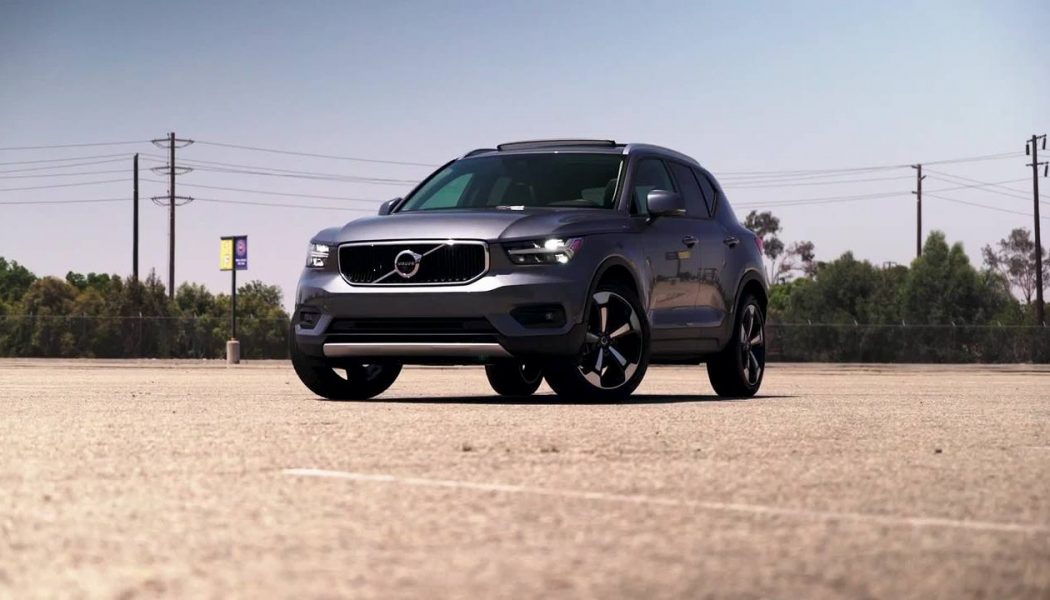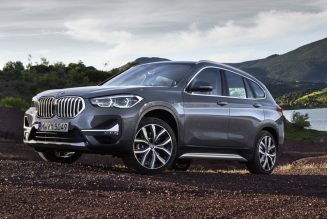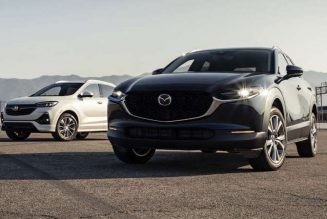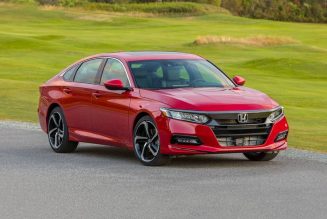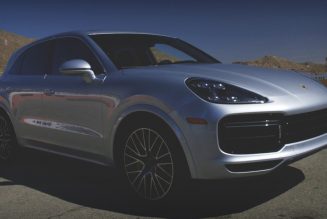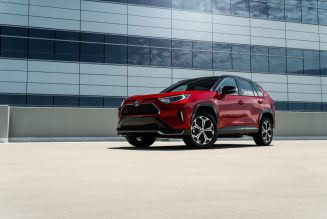Convenience. It all comes down to convenience. Our society is built around the convenience afforded by the internal combustion engine. Whether moving ourselves or our goods, gasoline and diesel have made everything possible. As has a network of hundreds of thousands of branded gas stations around the globe; miles apart or across the street, they allow us to refuel a vehicle in a matter of minutes. This is the market reality facing battery-powered electric vehicles. They’re catching up quickly, but even the best haven’t reached parity yet. When we ask which type of car we should buy, the answer is a question: What price will you pay for convenience?
For clarity, it’s useful to remove variables by examining a vehicle offering both types of powertrains—a situation that will only grow more common. In this case, it’s the gas-powered 2021 Volvo XC40 AWD T5 or the battery-powered 2021 Volvo XC40 Recharge AWD P8. It also helps to remember where we came from. The automobile arrived before the gas station, just as the electric car came before the electric vehicle charger. Bertha Benz had to convince the local druggist in Wiesloch to mix her up some ligroin (a petroleum-based solvent) to complete the world’s first automobile road trip when the ol’ Benz Patent Motor Car ran dry. Today, you can buy gasoline nearly anywhere on Earth.
Just as there was a druggist in nearly every village in 1888, there’s an electrical outlet in most inhabited places today. Depending on the supplies the druggist had on hand, it’s an even guess which would be a slower fill-up. Today’s gas stations can dispense 10 gallons per minute. High-speed electric chargers and the electric cars capable of taking advantage of them are narrowing the gap, but there are fewer than 150,000 of those chargers globally, and they’re not at all evenly distributed.
In the U.S. in 2020, for example, there were fewer than 4,000 fast chargers, compared with 168,000 gas stations, each with multiple pumps, per the U.S. Department of Energy and National Highway Traffic Safety Administration, and public charging stations are clustered in major cities and along major travel corridors.
This won’t be the case for long, though. The Biden administration has committed to building more than 500,000 public chargers by 2030. Private companies have pledged to build thousands more in the next few years. Vehicles able to take advantage of high-power charging are hitting the market, and more are promised every day. We’ve reached an inflection point in the mass adoption of the electric vehicle, the same way a horse-riding nation did with the automobile a century ago.
Where, though, does this leave today’s EV buyer? It depends. Right now, most EV buyers are homeowners who can plug in every night and need only visit a public charger on a road trip. Not ever having to visit a gas station is an oft-cited EV advantage, but otherwise, driving one to work or to run errands isn’t all that different from driving a gas-powered vehicle. Today, the road trip is the great equalizer.
Consider this comparison test a snapshot, the clearest look at the pros and cons of EV ownership compared to an otherwise identical gas-powered car in this moment.
XC40 Recharge EV vs. XC40 T5: The Ground Rules
To keep things as even as possible, I set some ground rules. Both vehicles would start with a full tank or battery. I would make a 400-mile round trip in both cars on back-to-back weekdays to guarantee each would be driven in the same manner and in as similar conditions as possible. I’d start at the same time each day and set the climate control at 72 degrees. I would drive as normally as possible, making no effort to game the results. I would do no advance research on gas station and charger locations. I would just get in the car and drive and figure it out on the way, just like most people do when they road trip in a gas-powered car.
The results speak to the central question: What cost convenience? The trips were remarkably similar. Each required a stop halfway to the turnaround point in Paso Robles, a stop at that point itself, and a stop halfway back. Traffic was effectively the same, as were the average speeds. The differences came in cost, both in terms of time and money, which each advantaged one vehicle over the other.
XC40 Recharge EV vs. XC40 T5: Dollars and Sense
In monetary terms, charging the Recharge three times on the trip and upon returning home cost between $66.29 and $70.20 for 187 kilowatts. Why the range? My home electrical utility charges different rates per kilowatt-hour of electricity depending on whether I exceed certain usage thresholds each month, so the price range reflects the lower and higher amounts I might be charged depending on the month.
Of that, $51.93 was spent on three public chargers. I used Electrify America chargers, as they were the only option for two of my three stops and accept credit cards rather than requiring a membership and a special RFID card. They charge $0.43 per kilowatt-hour. Given that 33.7 kWh equals the energy content of 1.0 gallon of gas, that’s like charging $14.91 per gallon. When there’s only one charging station on your route, though, what can you do?
The first stop cost $14.62 for 35 kWh and took 28 minutes. The second cost $18.39 for 42.75 kWh and took 33 minutes, partly because I switched chargers in the middle to allow a couple with a Nissan Leaf access to the only plug that fit their car. The third stop cost $18.92 for 44 kWh and took 31 minutes. Charging at home that night cost between $14.36 and $18.27 for 65.25 kWh and took nine hours. Public fast charging is expensive; hopefully that will continue to change with competition. (We did this same comparison with an identical loop a year ago in two Hyundai Konas, and the Kona Electric cost $140.97 to charge. So although public charging is still no bargain, it’s cheaper than it was.)
Filling the gas XC40’s tank is a much simpler calculation. Gassing up once on the road and again when I got home to see how much gas I’d used cost $73.94 for 17.11 gallons of the premium fuel required for the T5’s turbo engine. A small price penalty versus the Recharge EV version, but it’s worth noting I was able to comparison shop gas prices at different stations to save money, whereas I had virtually no alternative to the EV chargers I used and couldn’t go across the street to save a buck.
Measured in time, it goes the other way. The Recharge needed to be charged at the quarter, halfway, and three-quarter points of the journey. The T5 only required us to stop once for gas, on the way home. The entire trip in the Recharge took 9 hours, 11 minutes, compared to 8 hours, 31 minutes in the T5. That’s an increase of 7.8 percent, or 10 minutes per 100 miles traveled on electricity.
There are caveats, of course. The T5 only needed one stop for gas, but I also stopped once on the way out to use the restroom and at the turnaround point to eat lunch, so I ended up stopping the same number of times as I had in the Recharge. I was able to do those same things while the Recharge charged.
XC40 Recharge EV vs. XC40 T5: Let’s Be Real
Now, if you’re a road trip camel who can go hours without using a restroom or touching your phone, and if you bring your food and drink with you, you could shave time off the T5’s total, and using a vehicle that needs only regular unleaded would save 20 cents or so per gallon.
How much planning and personal discomfort are you willing to invest to get somewhere a little quicker or to save a buck? How much is it worth to have designated times off the road to check your phone safely? What’s the value to driving a vehicle that doesn’t pollute and that, even when considering materials and construction, creates less pollution in manufacturing? Does the convenience of stopping at a gas station for a matter of minutes rather than a charger for dozens of minutes outweigh all of that?
XC40 Recharge EV vs. XC40 T5: The Drive
Before you answer, consider the differences in the vehicles themselves. It’s not just what powers the wheels; it’s what they offer the driver and passengers.
Electric vehicles typically carry their weight lower, which automakers can take advantage of to improve handling. The Recharge EV rides and handles better than the T5, its battery pack’s lower mounting point reducing the SUV’s center of gravity and imparting a solidity and confidence typically found in German sport sedans. It has a carved-from-granite feeling, ironing out road rash better than the lighter T5 while also feeling more planted and resistant to body roll in corners. The T5 feels noticeably less refined and sporty by comparison, and the T5 is already a nice SUV, all things considered.
Similarly, there’s no question about the superior drivetrain. The T5 is reasonably quick getting up to speed on an interstate on-ramp and overtaking slow cars on the open highway, but it can’t hold a candle to the Recharge. The EV was quick enough to genuinely surprise our test team, and once you’ve had a taste of that instantaneous, linear power delivery, it’s hard to go back.
Whereas the T5 needs to change down a gear or three and the power comes in surges as the turbocharger spools up, the Recharge takes off like a shot every time. Enabling “one-pedal driving” not only allows you to recoup more battery power but also lets you drive the Recharge with extreme precision, simply by easing off the accelerator pedal.
But how much is the EV’s superior driving experience worth to you when weighed against the longer travel time?
XC40 Recharge EV vs. XC40 T5: Practical Matters
EVs have other inherent advantages. With no gasoline engine under the hood, the Recharge has extra cargo space up front (though it’s very small compared to most EVs). It’ll also never require an oil change, and a set of brake pads could last the vehicle’s entire life. There’s no timing belt or chain to replace, fewer fluids to leak, no emissions test to pass. How much are those conveniences worth compared to getting there sooner?
There are also bonuses specific to this particular EV. The XC40 Recharge gets several upgrades compared to the T5, the most significant being a Google-based infotainment system complete with Google Assistant. A million times better at understanding your questions and commands than any other voice-recognition software in any other car, the Assistant alone might be worth taking the EV leap. Don’t like digging through menus? Hate typing into the screen one peck at a time? Just say “Hey Google,” and tell Assistant what you want.
Normally, I’d do a bit of research and planning before an EV road trip, but I knew I didn’t have to this time because I could just tell Google where I wanted to go and ask it to find me a conveniently located charger along the way. And I could do all of this while driving down the interstate with Volvo’s Pilot Assist system helping me steer and handling throttle and braking. (The T5 had Pilot Assist, too.) And as I’d discover, Google Maps continues to better predict travel times and monitor traffic than automaker systems with the same live traffic-monitoring capability.
In addition, the Recharge has no stop/start button. Put it in gear (with one tap of the selector instead of the T5’s two, another minor advantage), and it wakes up and goes. It even sets and releases the parking brake automatically, including when you’re stopped on a hill. Both cars have a digital instrument cluster, but the Recharge’s shows you more information and is easier to read at a glance. The T5 is fairly quiet inside, but Volvo took additional steps in the Recharge to reduce noise, given its lack of engine sounds. The result is noticeable and appreciated. What are all those little conveniences worth compared to the convenience of stopping less frequently for fuel in the T5?
The gas T5 does have its advantages, though. For one, the air conditioning is considerably more powerful, likely the result of a less powerful electric compressor used on the Recharge to maximize range. I also felt slightly freer to drive as aggressively as I liked in the T5.
Even having a charger set as my destination in the Recharge and knowing I’d arrive with plenty of battery left, there was always a small voice in the back of my head cautioning against accelerating hard on hills, passing too many cars, or setting the cruise control too high, lest I burn too much electricity (which I ignored for the sake of matching driving aggressiveness for this test). In the T5, there was security in knowing I could find a gas station at nearly every exit on the interstate. How much are colder air and a little peace of mind worth weighed against all of the Recharge’s other advantages?
XC40 Recharge EV vs. XC40 T5: Which Way to Go?
Before I finally answer our grand question, I have to consider the context. This test was performed in California, the national leader in EV charger proliferation. The Recharge EV costs an extra $14,740 as tested, before tax incentives worth more than half the difference, and before counting fuel and maintenance savings over the vehicle’s life span. If I say it’s the better car and worth the extra expense after weighing the advantages and inconveniences of each, I say so based on my access to the charging infrastructure.
In that regard, I do say so. I’d rather drive the Recharge every day and deal with the inconvenience of longer travel times on road trips. The driving experience, the features, the never having to visit a gas station, the knowledge I’ve reduced my contribution to air pollution, they’re all worth a bit of my time. And remember, before long, EVs will charge substantially quicker than the Recharge does today.
If you don’t have a charger at home or if you live somewhere with fewer public chargers, your calculus will be different. But with thousands of new public chargers installed every year, your calculation will change by the day. Right now, the gas-powered vehicle will get you there sooner with the knowledge you can stop almost anywhere to refuel without any planning whatsoever. That may not be the case soon. Knowing most people keep their cars upward of 10 years, you have to ask: What’s convenience worth to you today, and what about tomorrow?
| POWERTRAIN/CHASSIS | 2021 Volvo XC40 P8 AWD Recharge (R-Design) | 2021 Volvo XC40 T5 AWD (R-Design) |
| DRIVETRAIN LAYOUT | Front/rear-motor, AWD | Front-engine, AWD |
| ENGINE TYPE | AC permanent-magnet electric motors | Turbocharged I-4, alum block/head |
| VALVETRAIN | — | DOHC, 4 valves/cyl |
| DISPLACEMENT | — | 120.2 cu in/1,969 cc |
| COMPRESSION RATIO | — | 10.8:1 |
| POWER (SAE NET) | 402 hp (comb) | 248 hp @ 5,500 rpm |
| TORQUE (SAE NET) | 486 lb-ft (comb) | 258 lb-ft @ 1,800 rpm |
| REDLINE | — | 6,000 rpm |
| WEIGHT TO POWER | 11.8 lb/hp | 15.4 lb/hp |
| TRANSMISSION | 1-speed automatic | 8-speed automatic |
| AXLE/FINAL DRIVE RATIO | 8.57:1/8.57:1 | 3.33:1/2.24:1 |
| SUSPENSION, FRONT; REAR | Struts, coil springs, anti-roll bar; multilink, coil springs, anti-roll bar | Struts, coil springs, anti-roll bar; multilink, coil springs, anti-roll bar |
| STEERING RATIO | 15.8:1 | 15.8:1 |
| TURNS LOCK TO LOCK | 2.7 | 2.7 |
| BRAKES, F; R | 13.6-in vented, disc; 13.4-in vented disc, ABS | 12.7-in vented, disc; 11.9-in vented disc, ABS |
| WHEELS, F; R | 8.0 x 20-in cast aluminum | 7.5 x 19-in cast aluminum |
| TIRES, F; R | 235/45R20 100H; 255/40R20 101H Pirelli P Zero Scorpion VOL EleGT (M+S) | 235/50R19 99H Michelin Primacy MXM4 (M+S) |
| DIMENSIONS | ||
| WHEELBASE | 106.4 in | 106.4 in |
| TRACK, F/R | 63.0/63.4 in | 63.0/63.6 in |
| LENGTH x WIDTH x HEIGHT | 174.2 x 73.3 x 65.0 in | 174.2 x 73.3 x 65.3 in |
| GROUND CLEARANCE | 6.9 in | 8.3 in |
| APPROACH/DEPART ANGLE | 20.0/26.6 deg | 21.7/30.4 deg |
| TURNING CIRCLE | 37.4 ft | 37.4 ft |
| CURB WEIGHT (F/R DIST) | 4,760 lb (52/48%) | 3,807 lb (58/42%) |
| TOWING CAPACITY | 2,000 lb | 3,500 lb |
| SEATING CAPACITY | 5 | 5 |
| HEADROOM, F/R | 37.6/38.3 in | 37.6/38.3 in |
| LEGROOM, F/R | 40.9/36.1 in | 40.9/36.1 in |
| SHOULDER ROOM, F/R | 56.7/56.3 in | 56.7/56.3 in |
| CARGO VOLUME BEH F/R | 57.5/21.7 cu ft | 57.5/21.7 cu ft |
| TEST DATA | ||
| ACCELERATION TO MPH | ||
| 0-30 | 1.8 sec | 2.0 sec |
| 0-40 | 2.4 | 3.2 |
| 0-50 | 3.2 | 4.5 |
| 0-60 | 4.2 | 6.2 |
| 0-70 | 5.4 | 8.2 |
| 0-80 | 6.9 | 10.6 |
| 0-90 | 8.7 | 13.7 |
| 0-100 | 10.8 | — |
| PASSING, 45-65 MPH | 1.9 | 3.3 |
| QUARTER MILE | 12.8 sec @ 107.7 mph | 14.7 sec @ 93.0 mph |
| BRAKING, 60-0 MPH | 118 ft | 111 ft |
| LATERAL ACCELERATION | 0.84 g (avg) | 0.86 g (avg) |
| MT FIGURE EIGHT | 26.3 sec @ 0.70 g (avg) | 27.4 sec @ 0.62 g (avg) |
| TOP-GEAR REVS @ 60 MPH | 6,350 rpm | 1,650 rpm |
| CONSUMER INFO | ||
| BASE PRICE | $55,085 | $42,045 |
| PRICE AS TESTED | $59,780 | $45,040 |
| AIRBAGS | 7: Dual front, front side, f/r curtain, driver knee | 7: Dual front, front side, f/r curtain, driver knee |
| BASIC WARRANTY | 4 yrs/50,000 miles | 4 yrs/50,000 miles |
| POWERTRAIN WARRANTY | 4 yrs/50,000 miles | 4 yrs/50,000 miles |
| ROADSIDE ASSISTANCE | 4 yrs/Unlimited miles | 4 yrs/Unlimited miles |
| FUEL CAPACITY | 78 kWh (Li-Ion battery, 75 kWh usable) | 14.2 gal |
| EPA CITY/HWY/COMB ECON | 85/72/79 mpg-e | 22/30/25 mpg |
| EPA EST RANGE | 208 miles | 355 miles |
| ENERGY CONS, CITY/HWY | 40/47 kWh/100 miles | 153/112 kWh/100 miles |
| CO2 EMISSIONS, COMB | 0.00 lb/mile (at vehicle) | 0.78 lb/mile |
| RECOMMENDED FUEL | 240-volt electricity | Unleaded premium |
